Welcome to Top Gun, Knight Hawks style!
Following the second Sathar War, UPF tacticans deduced that the star fighters were becoming a useless form of engagement. Typical practice at the time was to offer these jobs to low ranking unskilled pilots to give them time and experience to ultimately move up to larger fleet ships with more attractive mortality rates, such as the Assault Scout. The typical combat patterns indicated that larger ships tended to ignore the fighters, whose unskilled pilots had a difficult time hitting their intended targets and quickly depleted their limited supply of rockets, assuming they survived long enough to launch all three birds. More often than not the bigger enemy ships ended up treating them as pesky flies that could be swatted away at their convenience as opportunity presented itself. Mercenary Starbase, a privately funded organization backed by Star Law and Pan Galactic, began to initiate a competitive Star Fighter program, upgrading the basic fighter design as well as demanding new fighter designs along with offering special training for the fighter pilots. The new designs feature an auto-eject module (AEM) function where the computer's stress analysis programs determine when the hull is compromised, giving the pilots a good chance of survival if the ship is destroyed. Taking the lethality out of the equation started the new romance with these swift and soon to be deadly craft. With aggressive training, star fighter squadrons soon became a force to be reckoned with. They proved themselves time and again, and now it isn't too uncommon for pilots to stick around much longer despite being qualified to fly larger craft such as Frigates, Destroyers, or even Cruisers. Now the effectiveness of these new fighter squadrons is slowly taking center stage to the Assault Scout in the role of combat and warfare. A squadron (six) of these new smaller, faster, and deadlier craft manned by skilled operators can now overwhelm even the big cruisers with sheer speed and accuracy. When combined with the Assault Scouts, planetary militias no longer have to depend on an insignificant sized fleet of larger ships or the inability for spacefleet vessels to arrive in a timely manner during emergencies to protect their worlds. As a testament of their success, starfighter training is available at several locations now. Gollwin Acadamy now offers an alternative one year pilot training program (as opposed to their two year fleet program, although graduates are not automatically placed in Spacefleet but certainly are eligible), and similar programs can be found at Fotresses Kdikit (Madderly's Star), Redoubt (White Light), Pale (Truane's Star), as well as the original program at Mercenary Starbase in Zebulon. Graduates from any of those programs recieve the level:1 pilot skill and are commissioned into a one year tour of duty with the Star Fighter Corps. After completing the tour, pilots are eligible for service in any planetary militia as well as any available opportunities within Spacefleet. The Star Fighter Corps, founded shortly after the MS training program was established, is a tightly knit operation. Crews of fighter craft enjoy good pay and benefits packages as well as a sense of belonging in an organization that falls under both the local Planetary Militas as well as Spacefleet, but loosely attached to both at the same time. These star fighters and their crews can be easily transferred from location to location as the need arises, be it an individual pilot or an entire squadron of craft and their support crews. Since the star fighters are easily transported, via an available carrier or UPF Freighters, the SFC is an "on call" group that can be quickly dispatched anywhere with relative ease. As a result, fighter pilots and crews can find themselves working under Planetary Militia Defensive Fighter Squadrons and UPF Tactical Fighter Squadrons alike, and their rank and pay is easily transferable between the two. In other words, one month a fighter pilot, crew, and craft might be serving under a local Militia, and the next month could be spent aboard a UPF Assault Carrier. The following month one or more individuals could be transferred elsewhere, even to new and different fighter craft, all the while following orders under whichever command they are transferred to. The Star Fighter Corps is a very flexible but tightly knit outfit. While the pilots are the backbone of the Corps, technicians and Engineers are always in demand as well on the upkeep end of these fabulous spacecraft. Anyone with a technical skills that can pass local UPF or Star Law background checks will have no trouble finding work within the Star Fighter Corps, and a fine Starship Engineering program is also available at the same Pilot Training Facilities where technicians can learn the fundamentals of Engineering too, although their training is half a year followed by recieving LVL:0 Starship Engineering skill and another half year tour of duty. As an additional motive, star fighter crews with good service records have little trouble finding work following completion of their tour of duty. Some stick around and go as far as they can within the corps, while others find transfer into a local Militia or Spacefleet with little difficulty, granting them opportunities to find work aboard Assault Scouts, Frigates, or Destroyers.
|
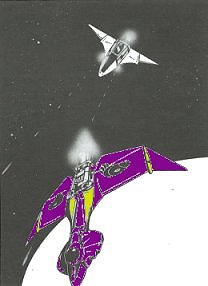 The Classic Dogfight Returns
The Classic Dogfight Returns
"This is Alpha Two, I've got one in my sights. Switching over to guns."
"Watch your six there Two, you got one on your tail!"
"I can't shake 'im!!!"
"Evasive maneuvers Two, I'm coming in at vector two five niner"
"Hurry up Chief, I can't hold this much longer"
"Yahoooo!!! Chalk up another one!"
"Thanks Alpha One, drinks are on me when we land!"
"Roger that Alpha Two, let's take out that other bogey and we can go home." Rank and File in the Star Fighter Corps
Following is a list of the rank and pay for star fighter pilots in the UPF Star Fighter Corps. Rank and pay is transferable between both Planetary Militia Defensive Fighter Squadrons and UPF Tactical Fighter Squadrons, but not applicable toward other Militia or Spacefleet titles and duties. Pilots FLIGHT TRAINEE: initial rank upon entering any Star Fighter Training School. No pay is recieved during this phase, but room and board along with other benefits are granted to enrolled students. FLIGHT CADET: rank granted upon succesful completion and certification from Training School. Take-home pay is 100Cr/day FLIGHT OFFICER: This rank is bestowed upon Cadets following combat missions, based on performance. Take-home pay is 125Cr/day LIEUTENANT: First major promotion, typically granted between half a year to a full year of service but often issued quicker during pressing circumstances such as war or lengthy battles. Take-home pay is 150Cr/day SQUADRON LEADER: The most senior rank among a six unit squadron is Squadron Leader, often bestowed upon Lieutenant grades as needed although on occasion exceptional Flight Officers will get bumped up to this position in dire emergencies. LVL:2 Pilot skill required. Take-home pay is 175Cr/day. Please note that a Squad Leader does not neccesarily outrank another Lieutenant on the ground, this is merely the recognized leader in a six unit squadron. CAPTAIN: Lengthy service with exceptional performance is rewarded with the Captain rank. Typically 1-2 years following the Lieutenant promotion and LVL:3 Pilot skill minimum and at least half a year of Squadron Leader status required prior to advancement to this grade. Take-home pay is 200Cr/day. Captains command all flights and squadrons and outrank all their pilots in a group, save for the Wing Commander. In fighter groups smaller than a Wing the Captain is treated as a Wing Commander in all respects, although when any friendly carriers that arrive insystem bearing a complete fighter wing, the Captain would temporarily fall under that squadron's Wing Commander for the duration of their stay. WING COMMANDER: Loyal Captains eventually recieve the coveted Commander position. The Wing Commander rank will not be issued to Captains serving in smaller fighter groups, in order to earn the rank one must serve under an actual Fighter Wing or be promoted to a Wing that needs a Commander. LVL:4 pilot skill is required along with a minimum of two years service as a Captain, although during wartime Squad Leaders may be promoted to Wing Commander, although this has yet to happen it is still possible if needed. Take-home pay is 250Cr/day Ground Crew TECH TRAINEE: initial rank upon entering any Star Fighter Ground Support Training School. No pay is recieved during this phase, but room and board along with other benefits are granted to enrolled students. TECH SUPPORT: rank granted upon succesful completion and certification from Ground Support Training School. Take-home pay is 75Cr/day DECK OFFICER: This rank is bestowed upon Tech Supports based on performance. Take-home pay is 100Cr/day FLIGHT DIRECTOR: First major promotion, typically granted between half a year to a full year of service but often issued quicker during pressing circumstances such as war or lengthy battles. Take-home pay is 125Cr/day FLIGHT CREW CHIEF: The Crew Chief is the senior officer assigned to one specific craft and coordinates the support team of that craft. LVL:1 Engineer skill required prior to this promotion, and take-home pay is 150Cr/day FLIGHT COORDINATOR: Top ranking position for a ground crew, the Flight Coordinator assumes command of all crews in a squadron. LVL:2 Engineer required for this rank and take-home pay is 175Cr/day. Fighter Squadron Terminology Fighter Wing: A Wing consists of at least two 6-unit squadrons, and can contain as many as six 6-unit squadrons. Squadron: a Squadron consists of 6 fighters, although Squadrons that don't serve under an actual Wing may have up to four reserve units. Any planet under the UPF will have at least one squadron per population rank in their militia, and outposts may have up to one full six unit squadron sans reserves. Flight: two fighters, one designated as Flight Leader (typically the higher ranking pilot, if both the same rank then bestowed upon the pilot with lengthier service) and the other is the Flight Leader's Wingman. A Squadron is subdivided into three 2-unit Flights, all of which answer to one Squad Leader. |
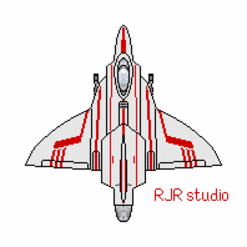 F-40C Vulcan
F-40C Vulcan
The original UPF fighter design recieves a new twist with the C model. In addition to the new auto eject modules, the C (for convertible) recieves a new weapon system. Rather than the original three assault rocket launchers, the C model offers three easily changeable weapon positions that can accept either the three rocket launcher systems for use against larger intruding ships or a single long range Pod Laser system for routine patrol duty. Pilots can be recalled for quick exchange from system to system as the needs present themselves. HS:1 HP:8 Powerplant: single sub-Atomic A drive
ADF:5 MR:5 DCR:30
Armamament: convertible AR(x3), PL + AR(x1), or PL(LR)
Defenses: RH, optional DS(5hp)
Communication/Detection: Subspace Radio, Radar, Videocom, AEM, Streamlined
Crew:1-2 Computer
Alarm (1), Analysis (3), Assault Rocket (1), Astrogation (1), Computer Lockout (4), Damage Control (1), Drive (3), Information Storage (1), Laser Cannon (1), Life Support (1), Maintenance (1)
|
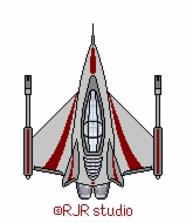 P-4 Ranger
P-4 Ranger
The P-4 Ranger was designed by spec for Mercenary Starbase requirements. This new star fighter design offers both weapon systems (in smaller packages) from the F-40C but available at the same time. One design surprise surfaced during testing though, once the assault rocket payload was delivered engine performance increased, which the P-4 pilots really got a kick out of. HS:1 HP:8 Powerplant: dual sub-Atomic A
ADF:5 (6 after AR depletion) MR:5 DCR:30
Armament: AR(x1), PL
Defenses: RH, optional DS(5hp)
Communication/Detection: Subspace Radio, Radar, Videocom, AEM, Streamlined
Crew:1 Computer
Alarm (2), Analysis (3), Assault Rocket (1), Astrogation (1), Computer Lockout (4), Damage Control (2), Drive (3), Information Storage (1), Laser Cannon (1), Life Support (1), Maintenance (2)
|
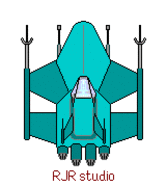 RF-41 and S/RF-41 Seeker
RF-41 and S/RF-41 Seeker
The Seeker was originally a low budget design, but with a few minor tweaks here and there it too became a formidable machine worthy of the name "star fighter". A surveilance/recon package is also available for the S designation which includes recording equipment and sensor jamming devices. Unlike the other HS:1 fighter craft, the Seeker is an interstellar fighter and can jump from system to system if needed. HS:1 HP:8 Powerplant: four Ion A drive
ADF:5 MR:3 DCR:30
Armamament: PL, IC
Defenses: RH, optional DS(5hp)
Communication/Detection: Subspace Radio, Radar, Videocom, AEM, Streamlined; S model includes 1/2 camera system and radar jammer)
Crew:1-2 Computer
Alarm (4), Analysis (4), Astrogation (4), Computer Lockout (4), Damage Control (4), Drive (3), Information Storage (2), Laser Cannon (1, 2 programs), Life Support (1), Maintenance (4)
|
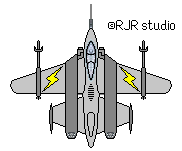 FX-10 Lightning Bolt
FX-10 Lightning Bolt
The Lightning Bolt was produced in response to the need for an advanced tactical fighter. Fast, highly maneuverable, and well armed, these ferocious fighters soon blazed their favored way into the hearts of their pilots. The Pod Laser systems are a linked system, that is the pilot has the choice fo firing the pod lasers separately (two shots each for 1d10 damage each hit) or in conjunction (for a single 2d10 damage shot). The Assault Rockets are also linked, the rockets can be fired separately (one rocket per combat turn) or the pilot can fire both simultaneously at the same target (successful hit means both rockets hit the target). HS:1 HP:8 Powerplant: two dual sub-Atomic A drives
ADF:6 MR:5 DCR:30
Armamament: PL(x2; linked), AR(x2; linked)
Defenses: RH, optional DS(5hp)
Communication/Detection: Subspace Radio, Radar, Videocom, AEM, Streamlined
Crew:1 Computer
Alarm (2), Analysis (2), Assault Rocket (1), Astrogation (2), Computer Lockout (4), Damage Control (2), Drive (4), Information Storage (1), Laser Cannon (1, x2), Life Support (1), Maintenance (2)
|
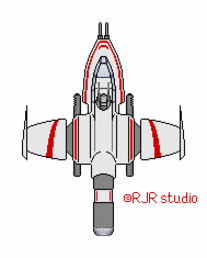 Sovereign Virtue I-76 Enforcer heavy fighter
Sovereign Virtue I-76 Enforcer heavy fighter
The I-76 Enforcer is an interstellar capable heavy fighter. Slow and sloppy by star fighter standards, the I-76 instead offers heavy armament and able to take a more serious beating. It has become well known as the "workhorse of the star fighter industry". HS:2 HP:16 Powerplant: shielded inboard/outboard single Atomic A drive
ADF:3 MR:4 DCR:45
Armamament: PL, AR(x4), IB
Defenses: RH, DS(6hp)
Communication/Detection: Subspace Radio, Radar, Videocom, AEM, Streamlined
Crew:2 Computer
Alarm (1), Analysis (4), Assault Rocket (1), Astrogation (4), Computer Lockout (4), Damage Control (1), Drive (4), Information Storage (1), Laser Battery (1), Laser Cannon (1), Life Support (1), Maintenance (1)
|
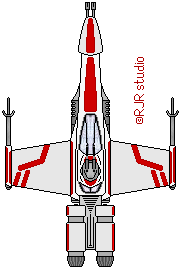 SF-1 Dagger
SF-1 Dagger
The SF-1 Dagger "superiority fighter" is the latest design to be adopted into the ranks of the star fighters. Fast, furious, and armed to the teeth, opponents quickly feel its stinging blade and lethal bite. Following the trend of the I-76 heavy fighter and the RF-41 Seeker, the Dagger is an interstellar star fighter. HS:2 HP:12 Powerplant: four Atomic A drive
ADF:6 MR:4 DCR:40
Armamament: PL, IC, AR(x2), PLT
Defenses: RH, DS(6hp)
Communication/Detection: Subspace Radio, Radar, Videocom, AEM, Deluxe Astrogation package, Streamlined
Crew:2 Computer
Alarm (4), Analysis (4), Assault Rocket (1), Astrogation (4), Computer Lockout (6), Damage Control (4), Drive (4), Information Storage (3), Laser Battery (1), Laser Cannon (1, x2), Life Support (1), Maintenance (4)
|

